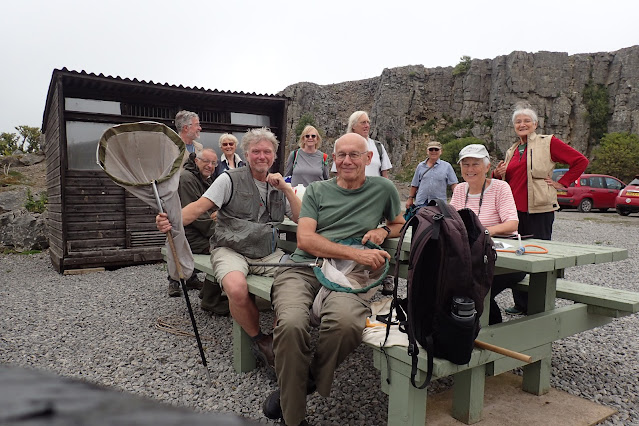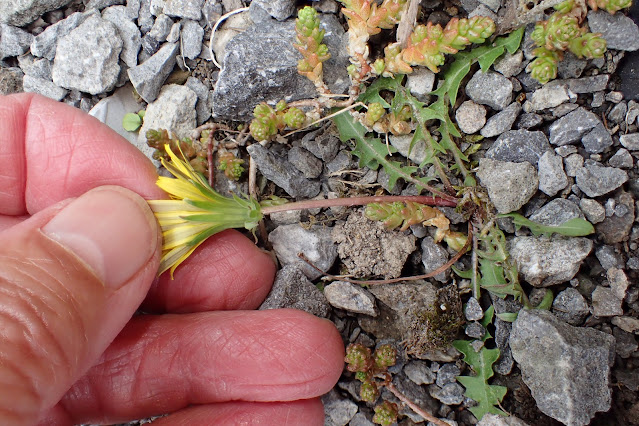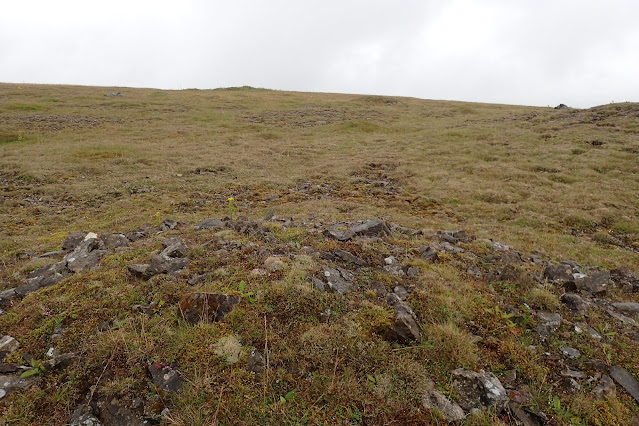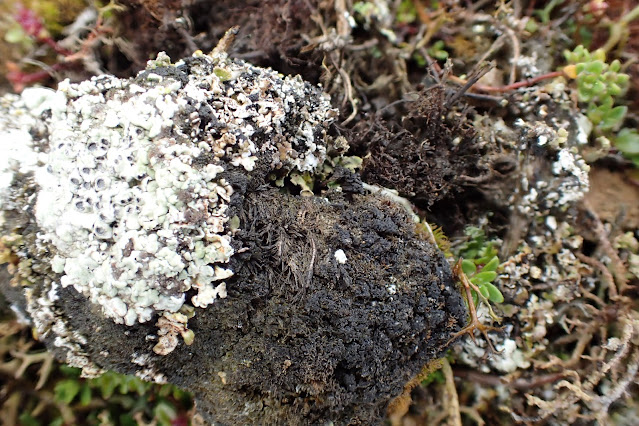The group "Christians Aware" have a summer school each year at Parcevall Hall in the Yorkshire Dales (between Appletreewick and Pateley Bridge). In 2023 I ran an afternoon session for them on Lichens. They later asked me to write a section on lichens for a book on biodiversity they were going to produce. On the Sunday evening 20 July 2025 I was invited to attend the evening meal at Parcevall Hall, so that I could be present when Barbara Butler introduced the new book "Rooted in Hope - A Christians Aware Resource towards building biodiversity". I was delighted to see the book.. I have written about the book here.
Here is a picture of us in 2023 on the terrace holding our hand lenses - this picture appeared in the book:
I had been scheduled to lead a visit on the Monday afternoon. Where to take the guests? Many of whom have attended these weeks here before.
I wanted to take them to places close to Parcevall Hall - there are so many good places within five miles as the crow flies. Places with wildflowers, with good views and with geological interest.
I say "as the crow flies". Parcevall Hall is built on a limestone slope, next to the North Craven Fault. To get there from anywhere involves driving either a spiral, (e.g. from Harrogate) or a zig-zag route (from Settle) to descend into the valley at 160m above sealevel then up the steep slope to the hall (260m) amongst its beautiful gardens. There is a view over the fault to the summit of Simon's Seat - a big hill (485m) made of millstone grit, just a mile away
I used the Monday morning to visit six possible places:
1. Coldstones Cut - Splendid viewing platform above the Hanson's Limestone Quarry at Greenhow.
2. Greenhow Burial Ground - which has good wildflowers
3. The road south of Greenhow - was it near any bog areas? I wanted to find a bog so I could talk to the group about peat.
4. Stump Cross Caverns - for the teashop - and information on caves
5. Grimwith Reservoir for the view of water
6. The roadside back down to Parcevall Hall for its wildflowers
The seventh possibility - the museum at Pateley Bridge - was not open on Mondays, so that was a non-starter.
1. Coldstones Cut - Splendid viewing platform above the Quarry at Greenhow.
There is a good view of the Vale of York from the car park on the main road. The walk to the summit was billed at 500m from the car park - i.e half a kilometre. It certainly took me all of 15 minutes to reach the top of the spiral viewing platform.
 |
| At the top left of the picture you can see the Millstone Grit summit of Simon's Seat which is close to Parcevall Hall |
2. Greenhow Burial Ground at Greenhow village
Although I have seen a good variety of plants there before, I could not see any plants that I thought would impress the group today - and would not want to take them trampling round anyway.3. The road south of Greenhow - Was it really close to any bog areas? Answer: No it wasn't. - And I remembered how straight the road is and how dangerously fast the cars travel.
4. Stump Cross Caverns and Café: No time to stop
5. Grimwith Reservoir: I drove to the car park.
6. Roadside Verge: I found a suitable place to park where you could look down to Trollers Gill and see to Gill Head where the last mine in the area to have been worked was situated - actually it was reworked, extracting fluorite from the mine spoil heaps.
I drove down to Parcevall Hall to hear the end of the morning talk by farmer John Dawson...and had lunch with the group.
In the afternoon we met in the lounge at 1.45 and as it was then raining a little I gave out hand lenses and explained to people how to use them. Put the lens really close to your eye, then bring your finger nail (or object to be examined) really close. The rain petered out and we set off.
We stopped at the road verge with a view back to the centre and to the valley leading to Gill Head. I asked each person to find a different wildflower. The verge was rich in wildflowers, unlike the adjacent heavily grazed fields, and there were no rare plants or orchids that people might inadvertently pick.
Elijah (from Kenya) chose Ragwort and was fascinated to discover that each "flower head" was made up of over 100 flowers "Bouquet of bouquets", he said ."Bouquet bouquet".
 |
| Tagwort. |
We pressed our flowers in a newspaper I had brought for the purpose.
Then carried on to Grimwith. On the way a participant in my car shouted "Orchids" so we stopped. There were lots of Common Spotted Orchids.
 |
| I took a phot of the spotted leaf of the orchid - and only later noticed I had a photo of this "Blob". I have been told it is a Trombid Mite - The group are known as Red Velvet Mites. The young stages are parasitic on insects, the older ones are predators of insects. |
 |
| Looking at Lichens on the fence. |
 |
| Oh no, more Garden Ladies mantle |
 |
| Peltigera praetextata - Dog Lichen |
 |
| I invited them to sit on benches in silence and listen to the birds and other sounds |
 |
| handlens |
Meanwhile here is the view I had when driving to Parcevall Hall from Settle via the Embsay and Eastby Road on the Tuesday morning: with a sudden surprise view of Lower Barden Reservoir. (I had always used this road at night before). then Simon seat on the right and Parcevall Hall amongst the trees above the valleys.


















































